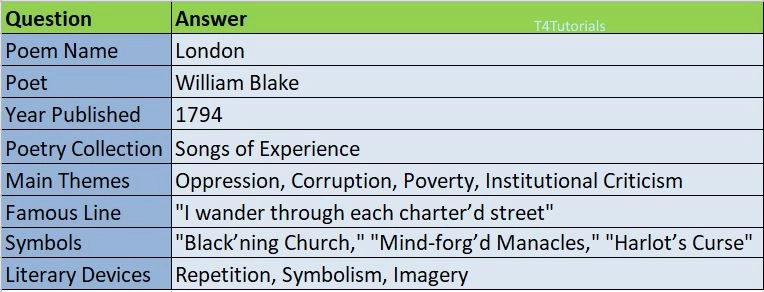Summary:
“London” is a dark, critical poem by William Blake, published in 1794 as part of his collection Songs of Experience. The poem depicts the suffering and oppression in the city of London during the Industrial Revolution.
The speaker walks through the streets of London and observes misery, poverty, and corruption everywhere. He describes the “marks of weakness, marks of woe” on people’s faces, symbolizing their oppression. The poem criticizes institutional control, including the monarchy, the church, and the government, for failing the common people.
Some of the powerful images in the poem include:
- “Every black’ning Church appalls” – Criticism of the Church’s hypocrisy.
- “The hapless Soldier’s sigh / Runs in blood down Palace walls” – A reference to the cost of war and monarchy’s indifference.
- “How the youthful Harlot’s curse / Blasts the new-born Infant’s tear” – A tragic image of disease and suffering caused by societal neglect.
The poem conveys themes of oppression, corruption, suffering, and the failure of institutions. Blake’s London is a place of despair, controlled by forces that strip people of their freedom and happiness.

Score: 0
Attempted: 0/10
Subscribe
| Question | Answer |
| Poem Name | London |
| Poet | William Blake |
| Year Published | 1794 |
| Poetry Collection | Songs of Experience |
| Main Themes | Oppression, Corruption, Poverty, Institutional Criticism |
| Famous Line | “I wander through each charter’d street” |
| Symbols | “Black’ning Church,” “Mind-forg’d Manacles,” “Harlot’s Curse” |
| Literary Devices | Repetition, Symbolism, Imagery |